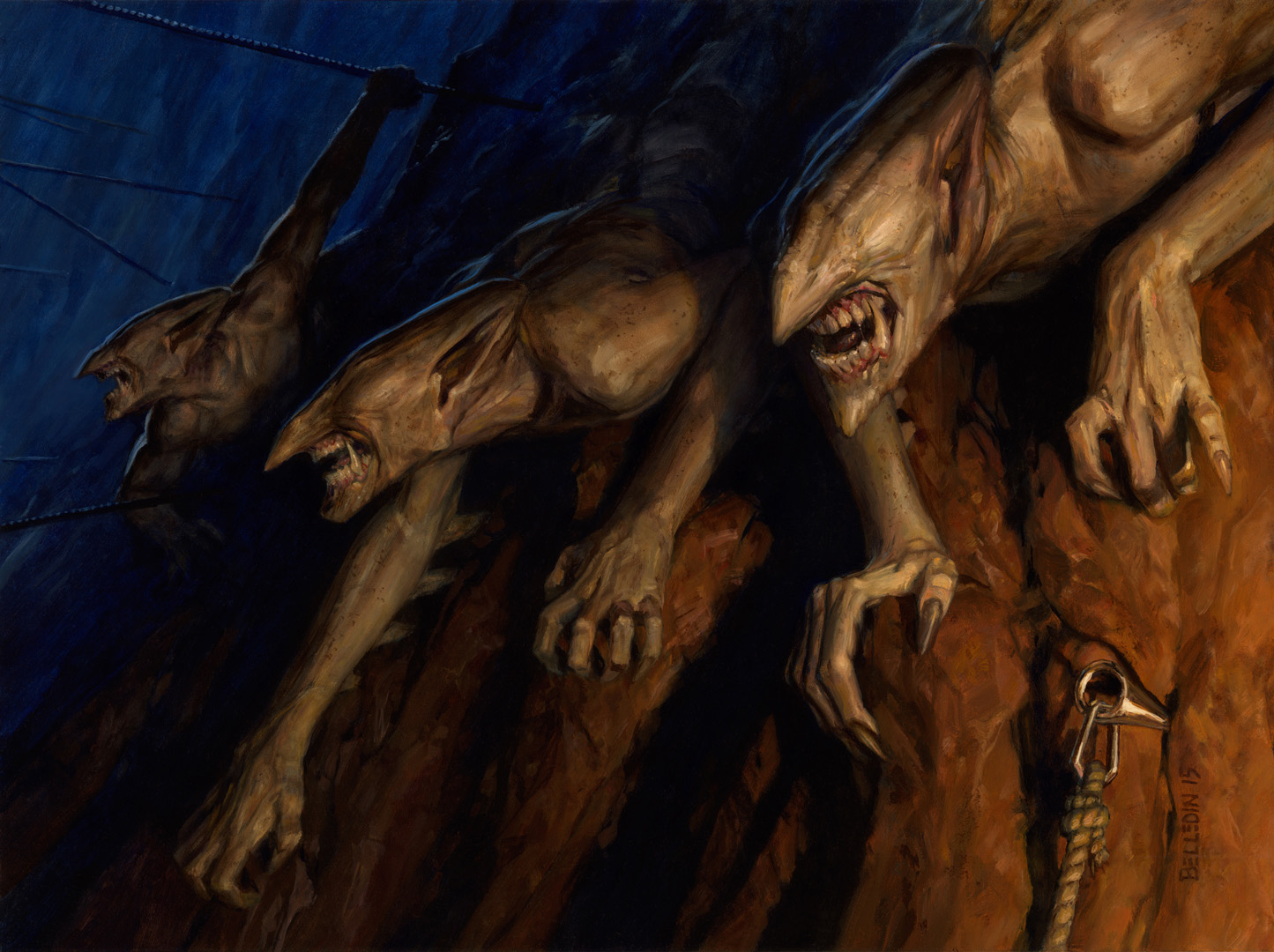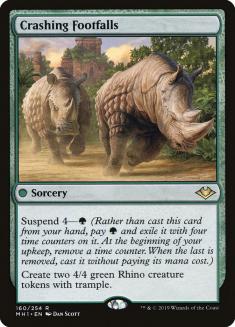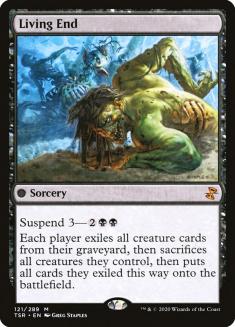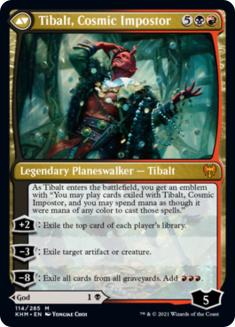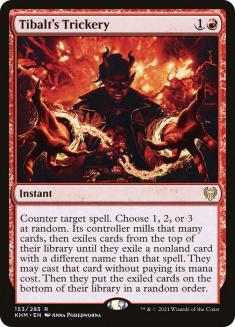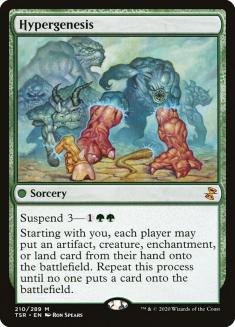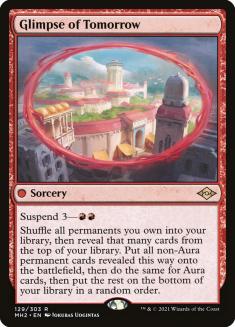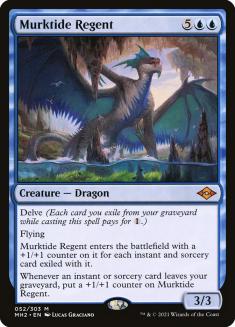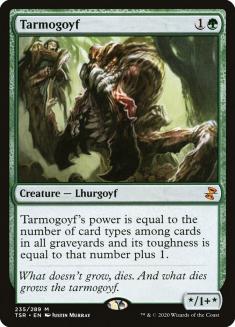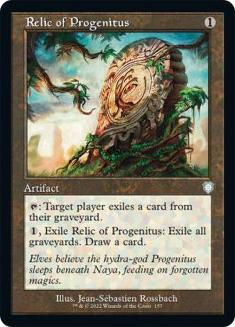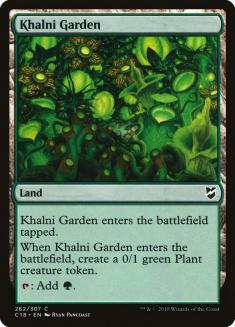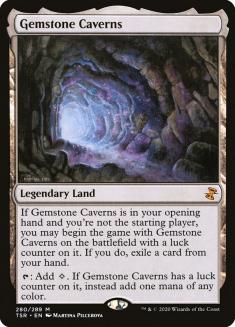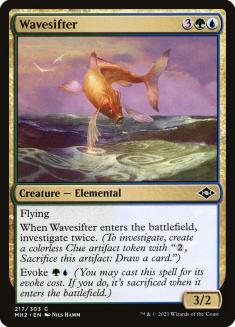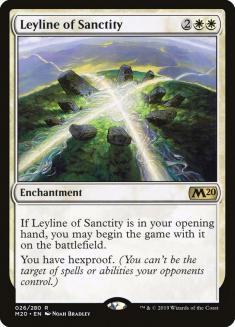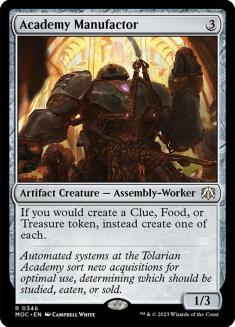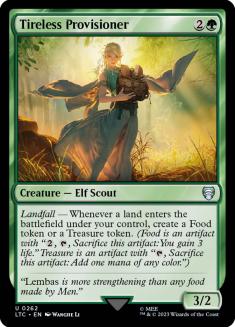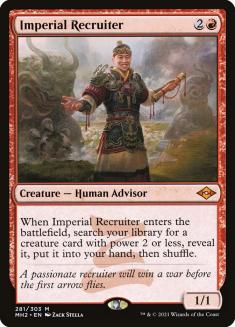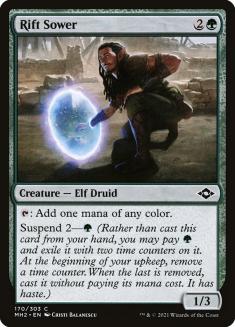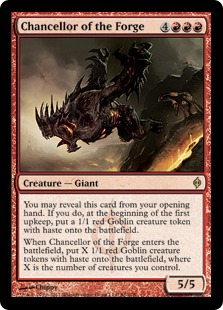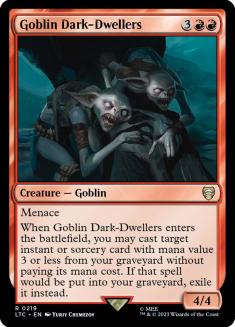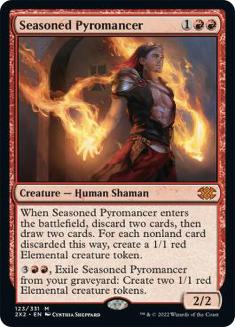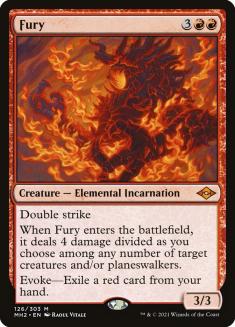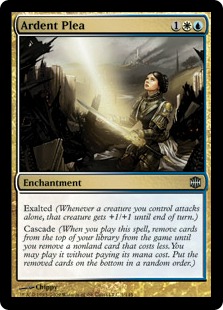The novelty has long since worn off the cascade decks in Modern. The unique deckbuilding incentives of warping your curve to meet the cascade restriction for Violent Outburst or Shardless Agent created an interesting puzzle at first, but the answer quickly became obvious (helped by the abundance of free spells like Force of Negation and Fury in both Modern Horizons sets).
The results are no longer that exciting. Temur Crashcade is more appealing in theory than in practice; the play patterns are more repetitive than the average midrange deck, as your entire roster of threats is condensed into the same card. The idea of using cycling creatures to enable cascading into Living End was a revelation when it appeared in Extended a decade ago, but that has been the same experience ever since despite some recent colour changes (in a shocking twist, the deck became better when it filled up on blue cards).
Other cascade combos proved so obnoxious that they were swiftly booted out of Modern or never allowed there in the first place. You start to wonder if these decks are doomed to fail from a design perspective…
Channel the Old Ways would have earned the dubious honour of being the most dangerous cascade deck of all! Luckily, its likely replacement strikes a perfect balance…
Glimpse of Tomorrow avoids the monotony of its colleagues with baked-in variance at both ends. You can amass permanents easily but slowly by playing normal Magic, but accelerating this without messing up your cascades is easier said than done. Your namesake spell doesn’t have a fixed outcome to play towards from Turn 1, and even when Glimpse goes on the stack, you have no idea how the game will look once it resolves. The more you shuffle creatures between zones, the better you know Living End will be. With Glimpse the most you can do is set the odds in your favour and see where the chips fall. Every Glimpse is an exciting event precisely because it offers no guarantee.
There’s also some amount of tension in deckbuilding between maximizing your permanent count pre-Glimpse, increasing the average impact of a permanent you hit with Glimpse, and staying functional in games where you can’t resolve Glimpse. It’s hard to find cards that work towards several of these goals at once.
All this makes Glimpse of Tomorrow a much more thoughtful and tolerable design than the other costless spells, but one that’s harder to use effectively. Players looking for a good time can warp their world to their heart’s content, but if you want to win, you have to confront the obvious question: why take a chance when you could lock in the consistency that has kept both of the surviving cascade decks at the top of Modern?
The biggest pitfall for Crashing Footfalls is that you can struggle to beat the battlefield. The threats in every other deck are so powerful — largely thanks to Modern Horizons 2 — that the rest of your deck can feel like it’s helping you catch up rather than pressing your advantage.
Meanwhile, Living End is fantastic at flipping the game state in its favour but faces more hurdles to making that happen. If explicit anti-cascade measures are at a low ebb right now, graveyard hate is at a high, and Living End is a big reason for that. Every opponent will have at least some relevant cards and many of these show up in maindecks. Urza’s Saga is on this list too — the threat of finding your Soul-Guide Lantern of choice puts Living End on a clock and bolsters any Saga deck’s Living End matchup at very little cost.
Glimpse of Tomorrow sidesteps all of that. Glimpse-specific hate like Grafdigger’s Cage is nowhere to be seen right now and ignores everything on the battlefield as long as your own battlefield is large enough to get the party started. You’ll always have a fail rate, even from a strong starting position, but you can bring this low enough that you’re happy to play those odds.
Early Glimpse lists were a natural homage to the Hypergenesis decks of old:
Creatures (16)
- 2 Iona, Shield of Emeria
- 4 Emrakul, the Aeons Torn
- 1 Ulamog, the Infinite Gyre
- 4 Shardless Agent
- 1 Brazen Borrower
- 1 Archon of Cruelty
- 3 Wavesifter
Planeswalkers (2)
Lands (21)
Spells (21)
- 4 Violent Outburst
- 4 Leyline of Sanctity
- 4 Omniscience
- 2 Fire
- 3 As Foretold
- 1 Valakut Awakening
- 3 Glimpse of Tomorrow
Sideboard

This list is built for one thing and one thing only: highrolling. It’s certainly satisfying to spin the wheel and flip a bunch of Eldrazi and other giant horrors onto the battlefield, but it was also a strategically sound approach while the format was still adjusting to Modern Horizons 2. When the cascade decks aren’t being explicitly targeted and Chalice of the Void isn’t in maindecks everywhere, it makes sense to pursue the most linear version of the deck with the highest upside.
Beyond that context, this approach also helps to mitigate the uncertainty built into Glimpse of Tomorrow. If you expect that you will have to fire off early Glimpses without time to set up, you want each possible hit to be as high-impact as possible — a small Glimpse that ‘just’ hits two lands and Emrakul, the Aeons Torn or Ugin, the Spirit Dragon is usually more than enough to win those games. With enough of these in your deck to hit them consistently with Glimpse, you’re also likely to draw some, suggesting Omniscience as a payoff of sorts that lets you unload other payoffs from your hand or immediately cast another cascade spell or Glimpse itself to reroll and go again.
This prototype is more ambitious with its Glimpses than later versions but has many of the same setup cards, reflecting the relative lack of options there:
The most natural way to build your battlefield is to make your land drops as normal. Lands that inflate your permanent count further are valuable there. Khalni Garden does this and can also soak up damage from any deck trying to race you in combat. That’s crucial when some of the fastest linear decks have Goblin Guide and Colossus Hammer.
Gemstone Caverns doesn’t bring any additional permanents but breaks the land drop restriction in a way no other card can and gives you a burst of speed on the draw to let you take another setup turn pre-Glimpse rather than having to spin the wheel as soon as possible. Caverns is a unique card that ought to be considered in a lot more decks, but it’s ideally suited to combo decks like this that reliably have spare cards in hand and need to reach an exact mana threshold quickly.
Limited workhorse Wavesifter was a subtle gift to this archetype as the best way to create material before Turn 3 that’s compatible with cascade. When you have to Glimpse several times, hitting Wavesifter with the first Glimpse ensures you get to go off properly with the next one. For the versions that can try to play fair, Wavesifter also offers a very slow way to dig for cascade spells and amass resources through disruption.
Leylines are fantastic nuclear options for Modern sideboards in general and even give you an effortless, free permanent for Glimpse. By itself this wouldn’t justify marginal or irrelevant Leylines, but both Leyline of Sanctity and Leyline of the Void are excellent in Modern right now. Leyline of Sanctity protects you from the hand disruption that’s the main or only way for many decks to interact with you, invalidates the hot new combo deck in Gruul Charbelcher, and buys endless time against the ever-present Boros Burn. Leyline of the Void shuts down a more esteemed cascade deck in Living End as well as Esper Reanimator and is subtly strong against Izzet Midrange, reducing their threat roster to just Ragavan and shielding your larger creatures from Unholy Heat.
This all-in approach is the most powerful in the abstract (and still the perfect call for a metagame where you expect little resistance) but suffered from recent metagame trends. The widespread adoption of Solitude made it risky to place all your hopes on one large threat. Teferi, Time Raveler contributed to this problem and created a hostile environment for cascade decks in general. Chalice of the Void isn’t the ubiquitous maindeck card it was a while ago but is still a sideboard staple for any non-cascade deck that wants it. Your Glimpse deck has to function without its namesake to be competitive these days.
Creatures (29)
- 3 Chancellor of the Forge
- 4 Shardless Agent
- 4 Goblin Dark-Dwellers
- 2 Seasoned Pyromancer
- 4 Omnath, Locus of Creation
- 4 Academy Manufactor
- 4 Tireless Provisioner
- 4 Wavesifter
Lands (24)
Spells (7)

The dedicated Academy Manufactor decks never got off the ground but the card shines here when you just care about game objects. Like many of the three-drop options it competes with, Manufactor hits that important overlap of both boosting Glimpse and being a good hit for it. With Wavesifter and Tireless Provisioner, it’s easy to flood the battlefield with so many widgets that Magic Online (MTGO) groans under the burden or that tiny table at your LGS runs out of space. Provisioner stuck around in lists without Manufactor as a way to create extra material for the second Glimpse or do an impression of Lotus Cobra to let you hard-cast your more expensive hits.
Creatures (30)
- 2 Imperial Recruiter
- 4 Chancellor of the Forge
- 4 Shardless Agent
- 3 Goblin Dark-Dwellers
- 2 Seasoned Pyromancer
- 2 Omnath, Locus of Creation
- 4 Rift Sower
- 4 Tireless Provisioner
- 1 Foundation Breaker
- 4 Wavesifter
Lands (22)
Spells (8)
Sideboard

This list from Eduardo Sajgalik features Rift Sower as a mana source that you can schedule to arrive on your Glimpse turn and props up the deck’s shaky manabase. Imperial Recruiter offers redundancy on your cascade spells by finding Shardless Agent; mid-combo, this lets you chain into a second Glimpse (while putting Agent onto the battlefield directly doesn’t, as you have to cast it to cascade). A small Recruiter toolbox with Foundation Breaker gives you outs to Chalice of the Void and could be extended to address other problems.
Beyond these individual quirks, a core of the deck starts to emerge and appears in the best-performing lists then and now:
Creatures (30)
- 4 Chancellor of the Forge
- 4 Shardless Agent
- 4 Goblin Dark-Dwellers
- 4 Seasoned Pyromancer
- 2 Omnath, Locus of Creation
- 4 Tireless Provisioner
- 4 Fury
- 4 Wavesifter
Lands (23)
Spells (7)

Creatures (28)
- 4 Chancellor of the Forge
- 4 Shardless Agent
- 4 Goblin Dark-Dwellers
- 4 Seasoned Pyromancer
- 4 Omnath, Locus of Creation
- 4 Fury
- 4 Wavesifter
Planeswalkers (1)
Lands (24)
Spells (7)

Chancellor of the Forge was an important find for this archetype, enabling and rewarding Glimpse at the same time more than any other card and converting an otherwise small Glimpse payout into a formidable battlefield. Its work is done immediately, making it ideal fodder for Fury or Seasoned Pyromancer, and the 1/1 token is not just free material but an immediate blocker for Ragavan even on the draw. You can shave Chancellor or cut it entirely in sideboarding when you expect games to go long or need space but it’s important for maximizing your consistency in Game 1. My attempts to build the deck without it to minimize the number of dead draws later only reinforced how strong it is there.
Pay attention to the order of operations. You want to stack Chancellor’s enters-the-battlefield trigger below Seasoned Pyromancer’s or Khalni Garden’s so that Chancellor sees those other tokens, and you want Chancellor’s trigger to resolve before Goblin Dark-Dwellers recasts your Glimpse. If your cascade spell is Violent Outburst (also a valid target for Dark-Dwellers here), all of this happens before Outburst resolves and the hasty Goblins from Chancellor will be pumped too, allowing for immediate wins in combat that are easy to miss if you don’t have Magic Online doing this bookkeeping for you.
Omnath, Locus of Creation does everything as advertised but somehow does even more than that. The various four-colour decks in Modern (often stretching their mana largely to access Omnath) each use it to stitch together absurd turns in their own way, but this is the rare deck that gets to use it as a combo piece.
A sufficiently large Glimpse is all but guaranteed to cycle through all of Omnath’s landfall triggers at once. You can use the burst of mana to go again with another cascade spell or Goblin Dark-Dwellers (a common way to parlay a small Glimpse into a larger one if you hit Omnath) or hard-cast Chancellor of the Forge. Between Goblin Dark-Dwellers, Fury, Wavesifter, and both ‘halves’ of Seasoned Pyromancer, you have a wide range of ways to manually chain Omnath into another relevant play with a fetchland in these fair games.
Goblin Dark-Dwellers lets you spin the wheel again for free off a resolved Glimpse. It’s cheap enough that you can build towards it in longer games when your first attempt at a Glimpse was blunted by disruption, often by buying back a discarded Violent Outburst.
Seasoned Pyromancer is everything you could ask for — up to three permanents in one card for Glimpse, a way to cycle expensive Glimpse payoffs and dig for your cascade spells, and a vital source of pressure against Teferi, Time Raveler. When your Glimpse plan is off-limits, Pyromancer converts those dead cascade spells into material to make the fair backup plan possible.
Modern players collectively discovered how strong the evoke Elementals were in the early days of Modern Horizons 2 and you see this shift in Glimpse lists too — Fury went from a neat sideboard card to an unsurprising maindeck staple. You have a high raw quantity of red cards and many of those are dead or situational draws — Chancellor of the Forge, a second copy of Fury or Omnath, Goblin Dark-Dwellers, redundant Violent Outbursts, and Glimpse itself (though suspending Glimpse with an eye to resolving it manually is a realistic plan often enough) — giving you a surplus of Fury fodder. A free Fury can boost your permanent count if you get to Violent Outburst into Glimpse in response to the evoke trigger, but Fury also helps that goal indirectly, as you can take more time on your own development when Fury has just stunted theirs.
This gives us a useful template, but filling out the rest of the deck is still an interesting and important puzzle.
The mostly Temur core already wants a light touch of white for Omnath. From there it’s simple to splash the other white tools open to cascade decks. Teferi, Time Raveler is excellent against any cascade pseudo-mirror and offers important protection for your combo (not just against interaction on the stack or troublesome permanents but against creature removal aimed at reducing your permanent count pre-Glimpse or breaking up a Omnath + fetchland sequence), but once again finds a combo-specific role in bouncing your own Shardless Agent or Ardent Plea to let you go again.
Temur Crashcade expert d00mwake (Devon O’Donnell) took that archetype to the next level with a larger and more colourful version that had roughly the same ratio of cascade effects as the standard Temur list thanks to Ardent Plea but leaned into white for Teferi and Solitude alongside Yorion, Sky Nomad for more late-game firepower. Why not try that approach here?
Creatures (29)
- 4 Shardless Agent
- 4 Seasoned Pyromancer
- 4 Risen Reef
- 4 Omnath, Locus of Creation
- 4 Solitude
- 1 Endurance
- 4 Fury
- 4 Wavesifter
Planeswalkers (4)
Lands (35)
- 4 Wooded Foothills
- 3 Windswept Heath
- 1 Snow-Covered Plains
- 1 Snow-Covered Mountain
- 1 Snow-Covered Island
- 1 Snow-Covered Forest
- 1 Sacred Foundry
- 1 Temple Garden
- 1 Steam Vents
- 1 Stomping Ground
- 1 Breeding Pool
- 1 Hallowed Fountain
- 2 Gemstone Caverns
- 4 Misty Rainforest
- 3 Scalding Tarn
- 4 Khalni Garden
- 3 Spirebluff Canal
- 1 Ketria Triome
- 1 Raugrin Triome
Spells (12)

I fell in love with this idea but suffered a swift collision with reality. The games I won were invariably thanks to the existing elements of the Glimpse core and I was winning fewer games because my smaller Glimpses couldn’t spiral out of control as often without the free reroll from Goblin Dark-Dwellers or the help on both ends from Chancellor of the Forge.
This initial failure was disappointing but illuminating, as it reaffirmed some strengths of Glimpse over its cascading competitors — you don’t need Solitude’s help post-Cascade to push your Rhinos through a massive Murktide Regent or Urza’s Saga Construct, and you have better creatures to fight fair through less hate than Living End. I had neutered a key strength of the deck without achieving anything necessary in return.
Further innovation in this space may come from a totally different direction. Nick Peternell’s attempt to graft a separate combo/ramp backup plan onto this core is music to my ears as a Primeval Titan enthusiast.
Creatures (27)
- 4 Primeval Titan
- 4 Shardless Agent
- 4 Goblin Dark-Dwellers
- 4 Risen Reef
- 4 Dryad of the Ilysian Grove
- 3 Omnath, Locus of Creation
- 4 Wavesifter
Lands (26)
Spells (7)
Sideboard

Dryad of the Ilysian Grove + Valakut, the Molten Pinnacle has been a successful focus of a wide range of decks in Modern and dodges the cascade-specific hate your opponents will lean on. Primeval Titan is this version’s big finish for Glimpse that will win the game outright with Dryad or put you in a dominating position otherwise. Dryad mangles your manabase further with Valakut, only to rescue it with its inbuilt mana-fixing. I especially like the use of Dwarven Mine as a way to let any fetchland bump up your permanent count.
Amulet Bloom went from a fun fringe deck to the best deck in Modern once players realizedthey could build it as a combo deck and ramp deck at the same time, with each half addressing the other’s weaknesses. That fusion isn’t quite as natural here but it’s an inspiring precedent.
I’ve had more fun building and playing with Glimpse of Tomorrow than any card in quite a while. With any luck, its result this past weekend is the start of a Belcher-esque breakthrough that will see it recognized as a competitive cascade deck — and not just the most interesting one.

